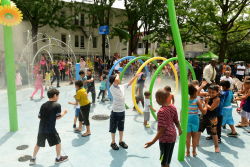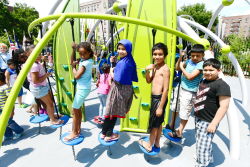Grand Playground
Grand Avenue Playground
This playground takes its name from the adjacent Grand Avenue, which runs parallel to the Grand Concourse. The concept for the concourse came from Louis Aloys Risse, an engineer in the office of Commissioner of Street Improvements Louis J. Heintz. The distinctive characteristics of his 1890 design were its remarkable breadth of 182 feet and its usage of varying elevations, with underpasses at large intersections, that allowed for an “express” lane of uninterrupted traffic.
The original plan, completed in 1909, ran from Mosholu Parkway down to East 161st Street. In 1927, it absorbed Mott Avenue, which ran from East 149th Street to this site on East 138th Street, making the total length of the Concourse four and a half miles. Throughout the first half of the 20th century, many of the boroughs main governmental buildings, major businesses, and exclusive residences were along the Grand Concourse.
In 1926, the Gold Star Mothers, whose sons gave their lives for America in World War I, petitioned for the road to be renamed Memorial Parkway. Although it was never renamed, for a long time the road did act as a memorial, with trees along it carrying metal name plates for Bronx residents who died in World War I. The trees were moved to Pelham Bay Park when a subway was completed under Grand Boulevard and Concourse in 1933. In 1927, there was another unsuccessful attempt to rename the road, this time by the Claremont Heights Civic Association to honor Woodrow Wilson (1856-1924).
Grand Avenue Playground is part of a long tradition of recreational parks in New York City. From 1865 to 1895, New York City's population more than doubled. As thousands of new immigrants moved into already overcrowded tenement districts, the streets teemed with children, many of whom worked long hours in factories. With the enactment of the first child labor laws at the turn of the century, leading reformers in New York City lobbied for the creation of a new kind of small park for children — the playground.
The earliest playgrounds, called "sand gardens," appeared in the 1880s on the grounds of settlement houses. Furnished with innovative play equipment like seesaws, and staffed by trained recreation specialists, the playground was designed to be a "healthful influence upon morals and conduct." As Theodore Roosevelt (1858-1919), 26th U.S. President and President of the Playground Association of America, wrote: "If we would have our citizens contented and law-abiding, we must not sow the seeds of discontent in childhood by denying children their birthright of play." For these reformers, recreation was not an end in itself: it was directly linked to the preservation of social morality.
In 1903, the first municipally run playground in the United States, Seward Park, opened on the Lower East Side. During the Depression, federal aid through the Works Progress Administration enabled the City to greatly expand and improve its play spaces. Under the strict stewardship of Parks Commissioner Robert Moses, new playgrounds were constructed at an astonishing rate throughout the decade. Moses was able to harness the massive manpower of the Parks Department, whose ranks had swollen to more than 80,000 workers due primarily to the influx of federal money for large public works projects. When Moses became commissioner in 1934, there were only 119 playgrounds in New York City. By 1960, the end of Moses’s reign at the Parks Department, there were 777.
Parks acquired the original .26-acre plot for Grand Avenue Playground on July 17, 1979. An adjacent .11 acre piece of land along West 181st Street was assigned to Parks on September 14, 1995. The property is bounded by Grand Avenue and Davidson Avenue at West 181st Street. On June 18, 1987, Commissioner Stern named it Grand Avenue Playground. Mayor Giuliani funded $41,971 in improvements, which were completed on October 13, 2000.
Check out your park's Vital Signs
Clean & Safe
Green & Resilient
Empowered & Engaged Users
Share your feedback or learn more about how this park is part of a
Vital Park System










